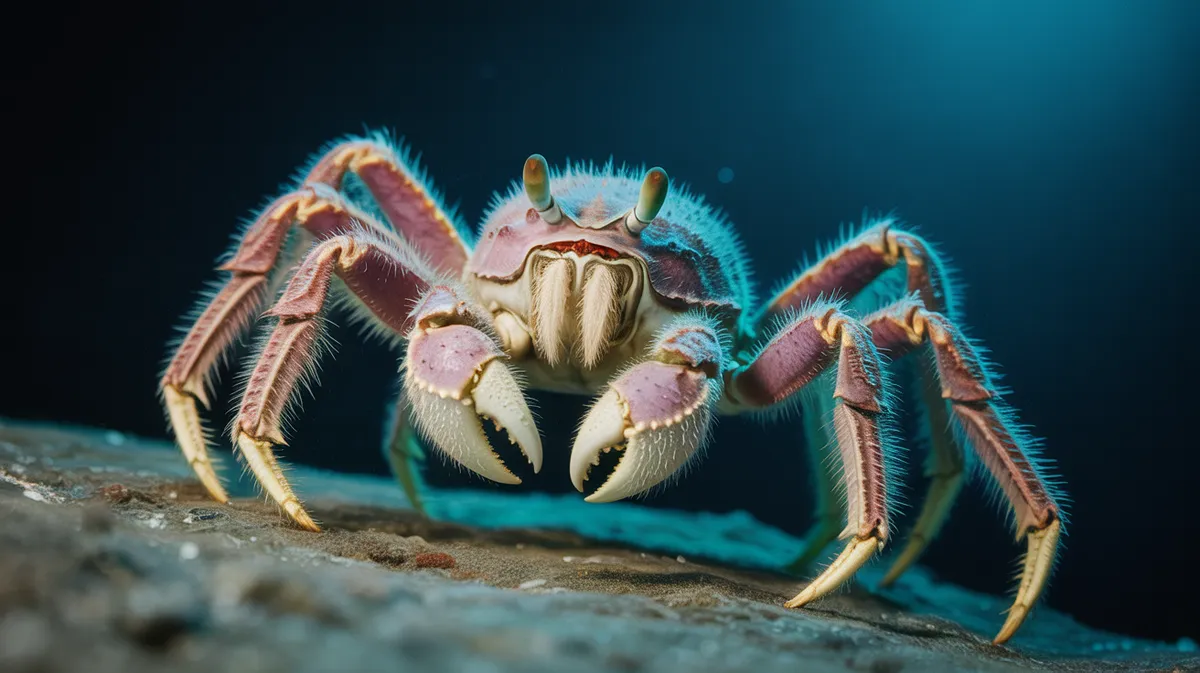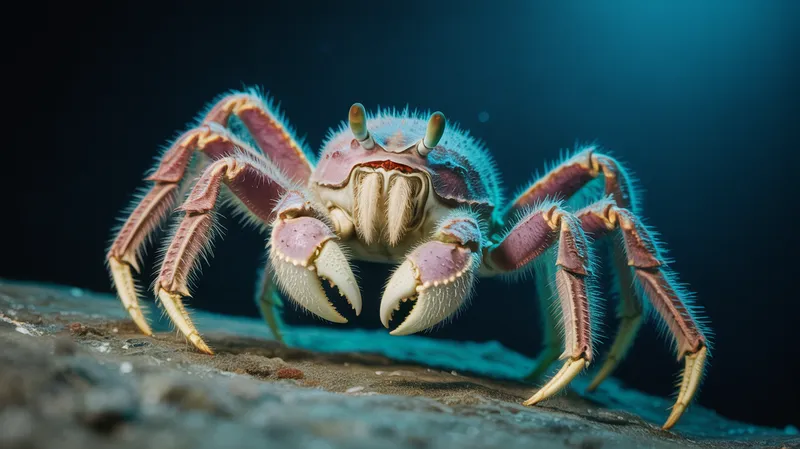
Yeti Crab
Kiwa hirsuta

Meet the Yeti Crab
The Yeti Crab, scientifically known as Kiwa hirsuta, is a deep-sea crustacean discovered in 2005 near hydrothermal vents in the South Pacific Ocean. This unique animal is characterized by its pale, almost translucent body and distinctively hairy, bristle-covered pincers, which are believed to house bacteria that help detoxify poisonous minerals from the vent fluids. Unlike most crabs, it lacks pigmentation and has reduced eyesight, adaptations to its dark, extreme environment. The species primarily inhabits hydrothermal vent ecosystems over 2,200 meters deep, where it lives in close association with chemosynthetic bacteria.
Classification
Invertebrate
Habitat
Deep-sea hydrothermal vents
Diet
Omnivore
Lifespan
Unknown (estimated several years)
Conservation
Data Deficient
Weight
Approximately 300-500 grams
📖Fascinating Facts
Hairy Pincers
The Yeti Crab's pincers are covered in silky, hair-like setae that host colonies of beneficial bacteria.
Extreme Habitat
It thrives in hydrothermal vent systems at depths exceeding 2,200 meters, tolerating extreme heat and toxic chemicals.
Unique Feeding
Kiwa hirsuta may 'farm' bacteria on its setae, scraping them off to eat as a primary food source.
📋Detailed Description
Kiwa hirsuta, commonly known as the Yeti Crab, is a deep-sea decapod crustacean reaching up to 15 cm in length, including its chelipeds (claws). Its most distinctive feature is the dense covering of setae (hair-like structures) on its chelae and legs, which appear silky or bristly and are colonized by filamentous chemosynthetic bacteria. The body is soft, unpigmented, and almost translucent, an adaptation to the perpetual darkness of its habitat. The carapace is smooth and lacks the heavy calcification seen in many shallow-water crabs. Eyes are greatly reduced and lack pigment, rendering the animal effectively blind. The Yeti Crab possesses five pairs of thoracic legs, with the first pair modified into large claws. Its gills are highly specialized for extracting oxygen from low-oxygen vent environments. Internally, it has a simple digestive tract and a reduced heart, reflecting the low metabolic rates typical of deep-sea fauna. The species is adapted to life at hydrothermal vents at depths of 2,200–2,600 meters, where it occupies steep vent chimneys and sulfide deposits.
💡 Did you know?
Unlike most crabs, the Yeti Crab is nearly blind and relies heavily on touch and chemical cues to navigate its dark, high-pressure environment.
🔬Research & Sources
Wikipedia Summary
Kiwa is a genus of marine decapods living at deep-sea hydrothermal vents and cold seeps. The animals are commonly referred to as yeti lobsters or yeti crabs, after the legendary yeti, because of their "hairy" and bristly appearance. The genus Kiwa is named after the god of shellfish in Polynesian mythology. The genus is placed in its own family, Kiwaidae, in the superfamily Chirostyloidea.
Last Modified: 5/24/2025
🎭Behavior & Social Structure
Kiwa hirsuta exhibits a largely sedentary lifestyle, often observed clustering in dense aggregations near active hydrothermal vents. It uses its bristled claws to cultivate and harvest bacteria, which form a primary component of its diet. The crab rhythmically waves its setae-covered arms in vent fluids, likely to increase bacterial growth by exposing them to sulfide-rich water. Feeding is primarily achieved by scraping bacteria from the setae and transferring them to the mouthparts. While generally solitary in foraging, individuals tolerate close proximity, forming loose colonies that may number in the hundreds. There is little evidence of aggressive territorial behavior, likely due to the patchy and ephemeral nature of vent habitats. The species is presumed to be mostly nocturnal, although the absence of light at these depths makes circadian rhythms less relevant. Locomotion is slow and deliberate, minimizing energy expenditure in a nutrient-limited environment.
👶Reproduction & Life Cycle
Reproductive biology in Kiwa hirsuta is not fully understood, but like other deep-sea crustaceans, it is believed to have a slow reproductive cycle. Females carry fertilized eggs on their pleopods (swimmerets) beneath the abdomen, providing some degree of brooding and protection. Egg clutches are relatively small, reflecting the high investment in each offspring. Embryonic development is slow, likely taking several months due to low temperatures. Hatchlings emerge as planktonic larvae, which disperse in the water column before settling on suitable vent habitats. There is no evidence of parental care beyond brooding. Breeding is thought to be asynchronous, with no clear seasonality, as vent conditions are relatively stable year-round.
🛡️Adaptations & Survival
Kiwa hirsuta displays a suite of adaptations for survival in extreme deep-sea environments. Its hairy setae not only provide a substrate for symbiotic bacteria but may also serve a sensory function in the absence of vision. The bacteria metabolize toxic hydrogen sulfide from vent fluids, providing nutrition for the crab and detoxifying its immediate environment. Reduced pigmentation and eyesight are classic adaptations to aphotic (lightless) zones. The species has a low metabolic rate, allowing it to survive in an environment with limited food resources. Its exoskeleton is thin and lightly calcified, reducing energy costs associated with molting. The ability to tolerate high concentrations of heavy metals and sulfides is facilitated by specialized proteins and detoxification pathways.
📚Research Sources
🎨Cultural Significance
Although Kiwa hirsuta has no direct role in traditional human culture due to its inaccessible habitat, its discovery in 2005 captured public imagination and inspired comparisons to the mythical Yeti, hence its common name. The genus name 'Kiwa' references the Polynesian goddess of shellfish, reflecting its unique evolutionary lineage. The species has become a symbol of the mysteries and biodiversity of the deep sea, often featured in documentaries and popular science media as an example of extreme adaptation.
🔬Recent Research & Discoveries
Since its discovery, Kiwa hirsuta has been the subject of multidisciplinary research, particularly in the fields of symbiosis, deep-sea ecology, and evolutionary biology. Molecular studies have revealed that its symbiotic bacteria belong to groups capable of chemosynthesis, converting inorganic molecules into organic matter. Recent research has focused on the genetic basis of its adaptations to high sulfide and low oxygen environments. Ongoing studies are examining the population structure and connectivity between vent fields, as well as the potential impacts of deep-sea mining. The discovery of related species (e.g., Kiwa puravida, Kiwa tyleri) has expanded understanding of the family Kiwaidae and its evolutionary history.
🎥Wildlife Videos

Yeti Crab: The worm that survives even at the bottom of the sea | documentary video |
Yeti Crab: The worm that survives even at the bottom of the sea | documentary video | Discover the fascinating world of the Yeti ...
Net World Animals

The Yeti Crab: A Deep-Sea Enigma Documentary
Opening Scene A submersible descends into the dark abyss of the Pacific Ocean. The camera scans the ocean floor, revealing an ...
The Animal Planet World

The Mythical Hairy Crab of the Deep - Yeti Crab Facts - Animal a Day
Today we learn about the deep, abominable crab that was only just discovered this century, the Yeti Crab. Join this channel to get ...
Animal a Day

10 Unique Facts About the Yeti Crab | Echoes of Nature
Meet the Yeti Crab, a bizarre deep-sea creature that thrives in extreme ocean environments! ✨ Discovered only in 2005, this ...
echos of nature

Yeti Crab - 5 Minute Documentary
Embark on a mesmerizing five-minute documentary exploring the mysterious world of the Yeti Crab, a deep-sea wonder that has ...
Five Minute Documentaries

Ghostly Yeti Crab Swarms Discovered Near Antarctica #yeticrab #yeti #crabs #sea #ocean #nature
Ghostly Yeti Crab Swarms Discovered Near Antarctica National Geographic, Antarctica, discovery, discover, new, news, Yeti, ...
InFront
🌍Habitat Information
The Yeti Crab typically inhabits Deep-sea hydrothermal vents environments. Yeti Crabs have adapted to their environments with specialized features and behaviors.
Primary Habitat:
Deep-sea hydrothermal vents
More detailed habitat information will be available soon.
🛡️Conservation Status
The Yeti Crab is currently classified as Data Deficient. Conservation efforts are crucial for preserving this species for future generations.
Common Threats:
- 🏠Habitat loss and fragmentation
- 🌡️Climate change impacts
- 🎯Hunting and poaching
- 🏭Human-wildlife conflict
⚠️Threats & Conservation Challenges
The primary challenges facing Kiwa hirsuta are the instability and patchiness of hydrothermal vent habitats, which can be destroyed by volcanic activity or tectonic shifts. Human threats include deep-sea mining for polymetallic sulfides and other minerals, which can disrupt vent ecosystems. Climate change may also affect deep-sea currents and vent chemistry, indirectly impacting the species. The population size and trends are unknown, and the IUCN currently lists the species as Data Deficient. The specialized habitat requirements and limited dispersal ability make the species potentially vulnerable to environmental disturbances.
🔬Scientific Classification
Scientific Name
Kiwa hirsuta
Classification Hierarchy
🔍 About Taxonomic Classification
Taxonomic classification is a hierarchical system used by scientists to classify and organize living organisms based on shared characteristics and evolutionary relationships.
The system moves from broad categories (Kingdom) to increasingly specific ones, with each animal's scientific name typically consisting of its Genus and species.
📝Community Notes
Share your observations and insights about the Yeti Crab with our community of wildlife enthusiasts.
Join Our Community
Sign in to share your observations and connect with fellow wildlife enthusiasts.
Sign In to ContributeNo community notes yet
Be the first to share your observations about the Yeti Crab!
Explore Yeti Crab
Select a tab above to learn more about this amazing animal.
📸Photo Gallery
No photos available for this animal yet.
🌟Discover More Wildlife
Continue your journey of discovery with more fascinating animals from our database
